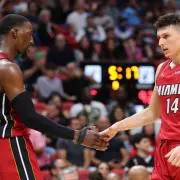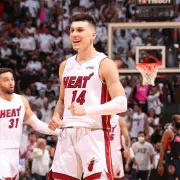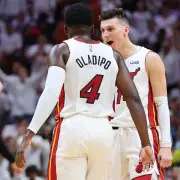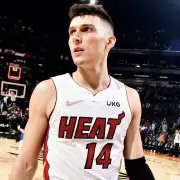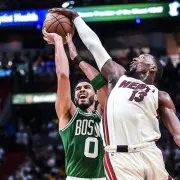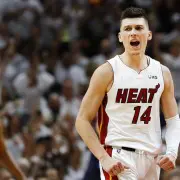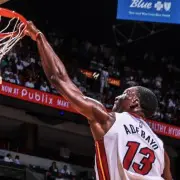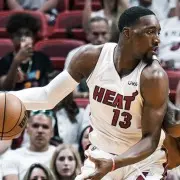The Heat’s Offensive Checkpoint: Tyler Herro-Bam Adebayo PnR
The hot topic surrounding the Miami Heat this week, with Media Day kicking off the week of training camp, has been all about starting lineups. There are three guys locked into their station, while the rest of the roster battles it out for those last two spots.
But it’s not just about being out there for opening tip-off, or having the ability to tell the world your a starter in this league. The most important element when having this discussion is overall fits, and maximizing this roster within that.
To that point, that walks us right into an area that I love to discuss: the basketball side of this.
When Bam Adebayo was asked about the way this roster can truly take the next step, his exact words were “it starts with me and Tyler.”
And that phrase is exactly how I view Miami’s offensive mold to begin the season: starting with Bam Adebayo and Tyler Herro.
Heading back to last season, we began to see the two of them emerge as not only the two young faces of this organization, but an upticking two-man game on the offensive side of the ball.
A high level offensive scorer when flowing downhill and a dominant rolling big man who’s as athletic as any big in this league. What’s not to love there?
The pick and roll showed to be a dominant pairing slightly passed the halfway mark of the regular season, leading to coach Erik Spoelstra thinking of ways to tinker.
As we all know, late in the season the team had to shake some things up with the rotation. The main one that gets brought up is Max Strus inserting into the starting lineup for Duncan Robinson, but there was an even larger adjustment behind the curatins.
The substitution pattern was altered. Herro would enter for Jimmy Butler much sooner, so that he could share the floor for added minutes next to Adebayo. Trust me, that was intentional.
Fast forward to the post-season, Herro had some challenges on his hands with different coverages. But one thing that popped off the screen, particularly in games 1 and 2 of the second round against Philadelphia, was that the pick and roll between these two guys couldn’t be stopped.
So they did just that: they didn’t stop going to it.
That got them to a 2-0 lead in the series, as we saw it sprinkled in a bit the rest of the series and into the Eastern Conference Finals against Boston.
But the point is this: that was just the precursor. We’re just scratching the surface on this two-man game to say the least. Not only will the frequency of reps be rising with Herro possibly slotting into that starting 2 spot, but their games are rising simultaneously.
So let’s take a dip into the different stages of a Herro-Bam pick and roll, and how it can evolve this year…
Step one of this process is the base blend. Noticing Herro’s favorite defensive coverage of drop, they begin to flow downhill. Jayson Tatum fights over the screen, which is exactly why I label this the base blend.
The last thing you want is for these two guys to get you on a 2-on-1. Bam stays linear with Herro in the pocket, Grant Williams must play middle man, and Herro floats right into his coveted pull-up jumper that simply can’t be altered once he begins to rise up.
The primary goal of this action is for him to find that pull-up, but the secondary goal is to play the mental game of the off-ball defenders. The thing to watch this season is the gravity on the weak-side, since if guys like Gabe Vincent, Caleb Martin, and others can make their defenders second guess, it’ll have Herro and Bam dominating with ease.
As seen in that clip above, Robert Williams is just trying to muck up the action by playing much lower than the nail. He’s a different kind of beast since he has the leisure to dip off far with his elite recovery speeds, but the point remains the same.
As much as they’re manipulating in the action, they’re also playing the long game to manipulate outside of the action.
So now, here will be the next adjustment.
Okay so we learned not to go over on this duo to create the 2-on-1 opportunity, so let’s try going under that screen. Well, Tyler Herro learned pretty quickly this season he has one option when seeing that while the big settles in deep drop: Pull. Up. Immediately.
He began finding himself as that instinctive shooter, but as seen in the clip above, this is the most common iteration of a team that prepares to go under. They’ll just play much higher in drop, eliminating that pull-up shot from him when rounding the screen.
{Bam Adebayo enters}
Now that 4 eyes and 2 bodies are on the wing next to Herro, the pocket pass quickly follows to a momentum filled Bam Adebayo.
When I asked Tyler Herro about this evolving two-man game, he said: “I love getting Bam the ball. He loves setting screens and getting to the basket for a lob or a pocket pass. Not many 5’s can stay in front of Bam, especially when he’s running downhill…Not many guys can stop him.”
That’s something that we know for a fact. Going back to the clip I’m describing above, take a look at the end result. What kind of weak-side help can do anything with that?
I’ll wait.
If his man is the one on the perimeter for the blitz, it’s like an open lane for a running back from there.
So what’s the next coverage to throw at them? We’ve hit on the normal drop when going over a screen. We’ve hit on the high version of drop when going under a screen. So how about we blend those two coverages together.
Herro flows left with a very solid screen from Bam that trips up Korkmaz a bit as he fights over. As we see from here, Joel Embiid is playing at the level of the screen to counteract the pull-up out of the 2-on-1, as I showcased earlier in this piece.
Instead, Herro keeps his dribble alive to force Embiid to drop into his slot on the rolling Bam, leading to an easy left handed lay-up.
The key to all of this is that these two guys have options. It’s just about manipulating those around them enough, while utilizing all the tools at their disposal. Too often we see them settle with simply the pull-up or pocket pass time and time again.
But as shown here, there are multiple options within the action depending on the coverage that they see. And the funniest part of this: I’m not even accounting for the off-ball stuff with the other three guys on the floor.
Options. Options. Options.
To play off the last coverage I displayed, there’s also the ability to play at a much higher speed than the slow-paced half-court set. We all know both of these guys have a tendency to play into the rhythm of the game, which most of the time deals with overall game speed.
For example, a drag screen from Bam on this occasion forces the defense into making quicker decisions with quicker feet. Maxey doesn’t see the screen and decides to fight over, Embiid scrambles to a driving Herro, and he easily slips right by for the crafty finish around the rim.
It’s one thing to bring up pace when discussing more transition opportunities, which both Bam and Herro have the capability of doing, but it just as much points to the authority of speeding up half-court sets.
You may be thinking that this has been very Tyler Herro centric for a piece that’s talking about a two-man game, but all of the plays I’ve displayed have been a 50/50 split in terms of effort.
Bam Adebayo’s screening, rolling gravity, and perfect positioning allows Herro to get many of those good looks out of this set.
But to focus a bit more on his scoring ability out of it, there are pretty much two primary steps for it to be successful.
Number one has a lot to do with the way teams decide to guard Herro as we went through, but more specifically, the blitzes will create non-stop opportunities for Bam as a scorer and play-maker.
In that clip above, he catches in space after Herro drew two, leading to a 1-on-1 at the rim against James Harden. (I like those odds)
The play-making part of the blitzing stuff is all about playing into the numbers. Two fly out on Tyler and Bam catches in space, you now have your athletic play-maker controlling a 4-on-3. (I like those odds too)
But back to the original point, the second step to Bam’s process is the expansion to come. We’ve gotten glimpses of the pocket pass into the elbow jumper, but that frequency rising bends this PnR duo to new heights.
Herro already provides the necessary mid-range gravity, yet if Bam is doing it similarly, even on a lower clip, it changes the outlook of defensive planning on the opposite side.
To finish this off, I’m pretty sure a lot of you may know where I’m going next. If I’m talking Bam, I’m talking inverted pick and roll.
It’s all about finding ways to put the ball in his hands as a scorer, but this is also an outlet to create mismatches. A guy like Herro or Lowry screening for Bam creates chaos if he approaches it correctly.
As seen above, the delayed switch allowed Bam to get to his spot and rise up. We can also add in the fact that Herro’s scoring gravity can create mis-directions as well, which all lean in favor of Bam finding slots to be productive.
Herro recently revealed that he’s currently at 198 pounds and 4.5% body fat, which is the lowest on the team, meaning that he may not be the most useful screener on the roster when evaluating on paper.
But as I just stated, much of the time it’s simply about creating chaos.
And that’s what this two-man game of Tyler Herro and Bam Adebayo will look to do this year on the offensive end.
“They’ve gained a lot of confidence in their two-man actions,” Erik Spoelstra said late in the playoffs last year about the Herro-Bam PnR. “They do a lot of different things with those actions and a lot of them are unscripted.”
Well now with another full off-season logged, we’re going to get a look at these two guys with the script in hand. And that script could end up making all the difference in this team’s half-court approach from October of 2022 to potentially June of 2023.
For the best daily fantasy props, and to double your deposit, use our code “five” at PrizePicks.com
